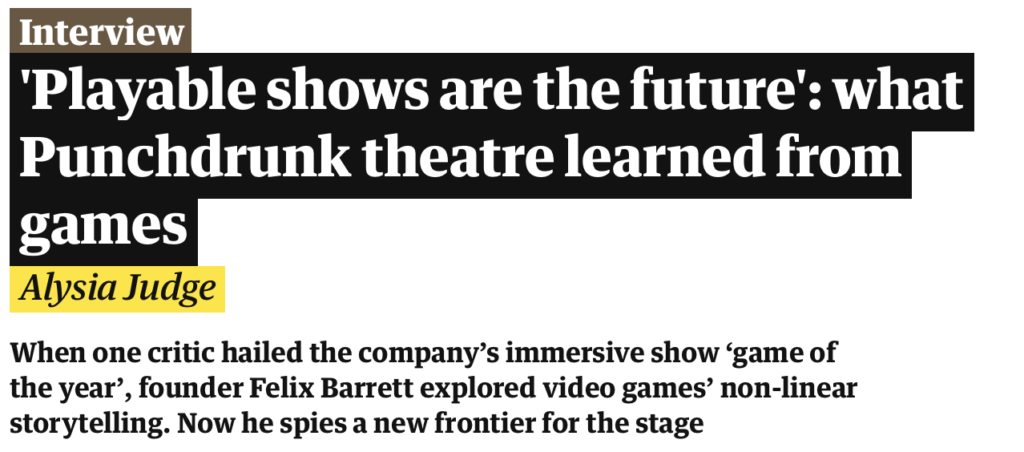In October, as part of our vacation to London, we took in two viewings of Punchdrunk’s latest production, The Drowned Man. Despite promises to write about it, I never did.
The show ended its run tonight. So what better time to finally try to draw some thoughts together than tonight, after the show can never be seen again?
The general format is, for the most part, as it was for Sleep No More: the masks; the loops; the roughly three hours; a vast space to explore.
The story is not Shakespeare, but instead Georg Büchner’s Woyzeck crossed with Nathanael West’s The Day of the Locust. The narrative is expressed through two parallel tracks running almost in mirrors through the space. It is not a 1920’s hotel in Scotland (actually a six story building in Chelsea), but a 1960’s American movie studio and surrounding village (actually an abandoned post office opposite Paddington Station). The cast feels exponentially larger: eight per “side” of the story, with fourteen in the middle, for a combined cast of around thirty.
With the mechanics out of the way, here are my scattered memories of the two visits, eight months removed:
After far too many visits to SNM, the struggle of trying to figure out a new space was such a joy. My mental map for the McKittrick is a seared memory, so to be faced with four gigantic floors and no sense of where anything was felt very liberating. It was also terrifying for the first hour, as the fear of missing out comes on strong.
I had always felt a little disappointment that there wasn’t more to be found in Sleep No More that was truly hidden – I’m aware of one passageway, and I was taken through it in my first visit. But the space in Temple Studios was full of these rooms – hidden behind curtains, across darkened hallways, and through tunnels in the sand. This made me ridiculously happy on multiple levels, and all of the rooms had that level of Punchdrunk set dressing love that I remembered so fondly. The reel-to-reel room, the sunflower room, the foley room; the entire desert floor, the church, the wardrobe; the Masonic Temple, the board room, the drugstore…so many of the rooms are unforgettable.
The soundtrack was impeccable, a mix of early 60’s American classics (think Shangri-Las and Avalons) and, strangely enough, the soundtrack from Perfume – The Story of a Murderer. “The Method Works!” is the most parallel to the use of Bernard Herman’s “Prelude and Rooftop” from SNM.
Casting was unsurprisingly strong, and it’s hard to not to want to give Sam Booth (in the above video) credit for his portrayal of Leland Stanford. He looms large over the goings-on, and hit just the right air of confident, disarming, and haunting.
It is rather tragic that TDM has come to a close, and while part of me wants to hope they’ll shut down SNM and convert the space, I also know that there aren’t many places in NYC that could contain that show. The space was truly massive, and as the obsessives on the TDM Spoilers FB group have detailed with the map, used very creatively. The majority of one of the floors was converted to an abandoned car park specifically for two characters to do one-on-ones in. I want to see the show live on, but I know the odds are slim.
If there is a lasting memory to be had of the show, it is this:
On our second visit, I applied the Don’t Stick Around For Scenes You’ve Already Seen rule, zipping out of a room if I got even the sense that I had perceived it before. Within my first half an hour, I came across a distraught woman in the saloon, being strongly compelled onto a stage. I stood close by and watched as Faye Greener – being played that night by Miranda Mac Letten – lip synced her way through Walking In The Sand by The Shangri-Las. It ended with her in tears, being comforted by her husband Harry, and returning to their run down room in the local motel.
That moment itself wasn’t the lasting memory. It was later in that show, when I happened into the same part of the loop and again saw Faye move towards the stage. And despite my better judgement and knowing I should go see someone else? I stayed put. It was that strong – that convincing – that I couldn’t look away.
And ultimately, that’s what I want out of theatre, and why I keep going back to immersive shows. I want the heart to win out over the head.
The Drowned Man is now closed. You can never go home anymore.


